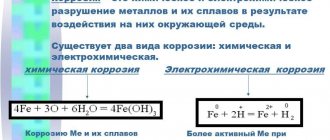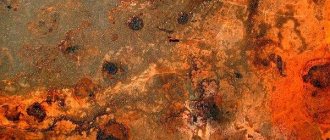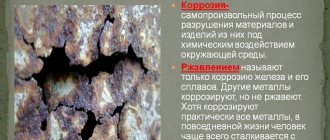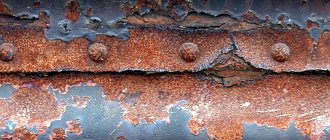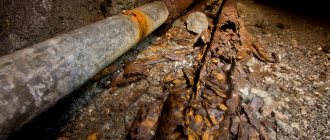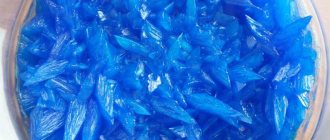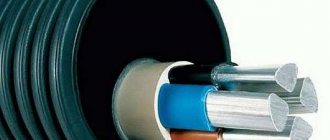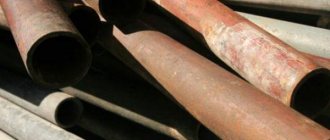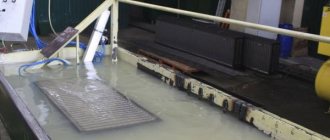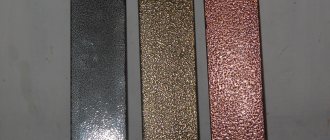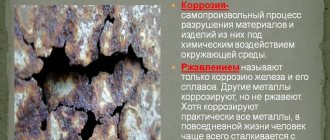Corrosion (from Late Latin corrōsiōn “to gnaw, chew”) is a gradually developing process of surface damage to metals that have the ability to actively react with oxygen. One clear example of this phenomenon is metal corrosion due to the formation of iron oxide Fe2O3 or rust. It is characteristic that the other two iron oxides - oxide FeO and oxide-oxide Fe3O4 - have a significantly lower corrosive ability, and Fe3O4 under some conditions can even play the role of a solid lubricant.
Corrosion theory suggests that for a metal to begin to deteriorate, four main components must be present:
- Cathode.
- Anode.
- The electrical connection that exists between the cathode and the anode.
- Electrolyte or any other conductive medium that facilitates the directed movement of ions.
The normal formation of rust on steel can be thought of as an electric battery. When metal atoms are exposed to an environment that contains oxygen, the metal produces electrons. This action can be locally limited to create a crack or micro-indentation. As the process progresses, corrosion spreads to the surrounding area, which will lead to a general deterioration of the surface condition. Limited (pitting) corrosion can cause metal fatigue - a decrease in its strength characteristics, and existing corrosive agents, for example, sea water, can lead to progressive crack growth.
The theory of corrosion also states that the intensification of surface destruction of metal is facilitated by microstructural changes that occur at elevated temperatures, in particular during welding. This is explained by increased values of activation energy, due to which the number of ions conducting electric current increases exponentially.
Definition of corrosion
Corrosion is the gradual destruction of objects, usually metals, caused by an active electrolyte environment and a chemical oxidation reaction.
The essence of the corrosion process is the presence of a constantly operating anodic reaction. It is caused by the dissolution of a metal, which generates electrons. Part of the activation energy is additionally spent on another process called the cathodic reaction. These two processes balance the charges produced. The zones causing these processes can be located close or far from each other, depending on the situation.
The electrons generated in the process must be consumed through a cathodic reaction. Hydrogen ions and electrons react to form atomic and then hydrogen gas. However, hydrogen is a powerful reducing agent, so further corrosion can be prevented by creating a thin film of gas on the metal surface. It serves as a polarizer, reducing metal contact with water and reducing corrosion. Thus, anything that destroys the barrier film increases the rate of corrosion.
The main factors determining the intensity of the process are:
- Speed;
- Temperature;
- The level of mechanical and thermal stresses that arise;
- The nature of the ongoing chemical reactions.
Corrosion hinders the introduction of new metal materials into production and causes significant damage to the economy.
Gas corrosion
Gas corrosion is the most common type of chemical corrosion. At high temperatures, the metal surface is destroyed under the influence of gases. This phenomenon is observed mainly in metallurgy (equipment for hot rolling, forging, stamping, parts of internal combustion engines, etc.)
The most common case of chemical corrosion is the interaction of metal with oxygen. The process proceeds according to the reaction:
Me + 1/2O2 - MeO
The direction of this reaction (oxidation) is determined by the partial pressure of oxygen in the gas mixture (pO2) and the dissociation pressure of oxide vapor at a certain temperature (pMeO).
This chemical reaction can occur in three ways:
1) pO2 = pMeO, equilibrium reaction;
2) pO2 > pMeO, the reaction is shifted towards the formation of oxide;
3) pO2 < pMeO, the oxide dissociates into pure metal and oxide, the reaction proceeds in the opposite direction.
Knowing the partial pressure of oxygen in the gas mixture and the dissociation pressure of the oxide, it is possible to determine the temperature range at which this reaction is thermodynamically possible.
The rate of gas corrosion is determined by several factors: ambient temperature, the nature of the metal or alloy composition, the nature of the gaseous environment, the time of contact with the gaseous environment, and the properties of the corrosion products.
The process of chemical corrosion largely depends on the nature and properties of the oxide film formed on the surface.
The process of the appearance of an oxide film on the surface can be divided into two stages:
— oxygen molecules are adsorbed on the surface of the metal, which is in direct contact with the atmosphere;
- metal reacts with gas to form a chemical compound.
At the first stage, an ionic bond occurs between surface atoms and oxygen: the oxygen atom takes two electrons from the metal. This creates a very strong bond, much stronger than the bond between oxygen and the metal in the oxide. Perhaps this phenomenon is observed due to the effect on oxygen of the field created by metal atoms. After complete saturation of the surface with the oxidizer, which occurs almost instantly, at low temperatures, due to Van der Waltz forces, physical adsorption of oxidant molecules can be observed.
As a result, a very thin monomolecular protective film is formed, which thickens over time, making it difficult for oxygen to reach.
At the second stage, due to chemical interaction, the oxidizing component of the medium takes away valence electrons from the metal and reacts with it, forming a corrosion product.
If the resulting oxide film has good protective properties, it will inhibit the further development of the chemical corrosion process. In addition, the oxide film greatly affects the heat resistance of the metal.
There are three types of films that can form:
- thin (invisible to the naked eye);
- medium (gives tarnished colors);
- thick (clearly visible).
In order for the oxide film to be protective, it must meet certain requirements: have no pores, be continuous, adhere well to the surface, be chemically inert in relation to its environment, have high hardness, and be wear-resistant.
If the film is loose and porous, and also has poor adhesion to the surface, it will not have protective properties.
There is a continuity condition, which is formulated as follows: the molecular volume of the oxide film must be greater than the atomic volume of the metal .
Continuity is the ability of the oxide to cover the entire surface of the metal with a continuous layer.
If this condition is met, then the film is continuous and, accordingly, protective.
But there are metals for which the continuity condition is not an indicator. These include all alkaline, alkaline earth (except beryllium), even magnesium, which is important technically.
To determine the thickness of the oxide film formed on the surface and study its protective properties, many methods are used. The protective ability of a film can be determined during its formation, by the rate of metal oxidation and the nature of the rate change over time. If the oxide has already formed, it is advisable to study the thickness and its protective properties by applying some reagent suitable for this case to the surface (for example, a solution of Cu(NO3)2, which is used for iron). By the time of penetration of the reagent to the surface, the thickness of the film can be determined.
Even the already formed continuous film does not stop its interaction with the metal and the oxidizing environment.
The influence of external and internal factors on the rate of chemical corrosion.
Temperature has a very strong influence on the rate of chemical corrosion. When it increases, oxidation processes occur much faster. In this case, the decrease in the thermodynamic possibility of the reaction occurring has no significance.
Variable heating and cooling have a particularly strong effect. Cracks form in the protective film due to the appearance of thermal stresses. Through cracks, the oxidizing component of the medium has direct access to the surface. A new oxide film is formed, and the old one gradually peels off.
The composition of the gas environment plays a major role in the corrosion process. But this is individual for each metal and changes with temperature fluctuations. For example, copper corrodes very quickly in an oxygen atmosphere, but is stable in an environment containing SO2. Nickel, on the contrary, corrodes intensively upon contact with an SO2 atmosphere, but is stable in O2, CO2 and H2O environments. Chromium is relatively stable in all four environments.
If the oxide dissociation pressure is higher than the pressure of the oxidizing component, the oxidation of the metal stops and it becomes thermodynamically stable.
The rate of oxidation depends on the composition of the alloy. Let's take iron, for example. Additions of sulfur, manganese, phosphorus and nickel do not affect its oxidation. Silicon, chromium, aluminum slow down the process. And beryllium, cobalt, titanium and copper greatly inhibit oxidation. At high temperatures, tungsten, molybdenum, and vanadium can intensify the process. This is explained by the volatility or fusibility of their oxides.
Observing the rate of iron oxidation at different temperatures, we note that with increasing temperature, the slowest oxidation is observed with an austenitic structure. It is the most heat-resistant compared to others.
The rate of chemical corrosion is also influenced by the nature of surface treatment. If the surface is smooth, then it oxidizes a little slower than a bumpy surface with defects.
Types of metal corrosion
All corrosion phenomena can be classified according to the following parameters:
- According to the degree of uniformity. A distinction is made between surface corrosion, which uniformly reduces the thickness of the surface, and uneven corrosion - pitting or pitting;
- According to the intensity of impact on the metal. For example, selective corrosion destroys only certain structural components, while contact corrosion affects the less corrosion-resistant (“base”) components of friction pairs;
- With intergranular corrosion, destruction occurs along the grain boundaries and spreads deep into the metal.
- Fretting corrosion, when two bodies in contact with each other perform oscillatory movements of small amplitude (no more than 100 microns) relative to each other.
When exposed to tensile stresses and an aggressive environment at the same time, corrosion cracking of an intergranular or transgranular nature is observed, and when alternating stresses are applied, corrosion-fatigue failure begins. Protecting metals from corrosion thus also involves simultaneously reducing wear of parts.
Next, we discuss the main phenomena that occur in damaged areas during various types of corrosion.
Types of corrosion according to the mechanism of the process:
— chemical is a type of corrosion destruction associated with the interaction of a metal and a corrosive environment, in which the metal is simultaneously oxidized and the corrosive environment is restored;
- electrochemical - the process of interaction of a metal with a corrosive environment, in which the reduction of the oxidizing component of the corrosive environment does not occur simultaneously with the ionization of metal atoms and their rates depend on the electrode potential of the metal.
Chemical
Chemical corrosion refers to the gradual destruction of a metal surface due to the reaction of the surface with substances in the external environment. It occurs as a result of metal oxidation with acids to form oxides.
The high-temperature option involves exposing the metal to dry gases. All metals in dry air are covered with a very thin (2...10 microns) layer of oxides. This layer is formed at very high temperatures, when the reaction with oxygen in the air occurs without any restrictions. At room temperature the reaction stops because the oxide film becomes too thin. In the case of, for example, aluminum, such a film consisting of Al2O3 oxide effectively protects the surface of aluminum cookware, since the corrosion resistance of pure aluminum is low.
Chemical corrosion begins at a place where the metal is under pressure and isolated from air circulation. This encourages metal ions to dissolve in a humid environment, which ultimately speeds up the reaction between them and water. The reaction produces hydrous oxides (known as rust when reacting with iron) and free ions.
Kinds
Corrosion can occur in the presence of electrolytes and non-electrolytes. Therefore, the main types of metal corrosion according to the mechanism of occurrence are:
- chemical – occurs in the absence of an electrolyte in a dry or humid environment;
- electrochemical - occurs in the presence of an electrolyte.
Chemical corrosion is associated with non-electrolytes - substances that do not conduct electric current in solutions or melts. Non-electrolytes include many simple inorganic (oxygen, hydrogen) and organic (ether, benzene) substances.
Chemical corrosion can occur in the presence of gases (hydrogen, oxygen, chlorine), organic acids and salts. Metal molecules combine with chemical elements, and films appear on the metal surface - oxides, sulfides, hydrides. Externally, this is noticeable by a change in color. Iron, combining with oxygen, forms Fe2O3 - iron (III) oxide - red rust.
Rice. 2. Iron oxide.
If the melt or solution contains substances that conduct electric current (electrolytes), then electrochemical corrosion occurs. It occurs in the presence of salts, acids, alkalis, or when the surfaces of two metals come into contact, between which there is a humid environment. Due to the difference in redox potentials, a galvanic element appears - a source of electric current. The metal acts as an anode (reducing agent), and the electrolyte acts as a cathode (oxidizing agent). The anode, giving up electrons, oxidizes or corrodes.
Rice. 3. Scheme of electrochemical corrosion.
Corrosion can be classified according to other criteria. According to the source of damage, corrosion occurs:
- local;
- solid;
- point.
Corrosion can occur in different environments:
- gas (anhydrous);
- atmospheric (humid);
- liquid;
- ground;
- radiation.
Salt speeds up the rusting process, so ships rust faster in sea water than in fresh water.
Electrochemical
To simulate the process, it is necessary to consider an iron plate coated with any electrically conductive coating, for example, oxide scale, which was formed during high-temperature processing. When the plate is immersed in a solution of sodium chloride, it is discovered that if the integrity of the scale is damaged, the rusting of the iron will occur much faster in this place. Electrochemical corrosion most reliably explains the rusting of iron under aerobic conditions.
The theory of electrochemical corrosion assumes the presence of additional chemical reactions:
- Fe → Fe ++ + 2e−, - anodic reaction;
- 2e− + O + H2O → 2OH− - cathodic reaction.
When metal ions dissolve, their charge is balanced by chloride ions, which migrate into the area of attack, attracted by the resulting positive ions. Ferric chloride dissolves in water, but this does not prevent further corrosion, since the ferric chloride solution is very acidic due to hydrolysis. As Fe++ ions are removed from this site, they encounter hydroxyl ions, which are either naturally present in the water or formed through a cathodic reaction. The result is the formation and precipitation of iron hydroxide Fe (OH)2. Further, in the presence of dissolved oxygen, it is quickly oxidized to iron oxyhydroxide FeOOH.
Thus, during electrochemical corrosion, three reactions occur, and in three different places. Anodic occurs in areas of metal loss, cathodic - where oxygen dissolved in water can accept electrons, and solid scale itself is formed in places of mechanical damage on the surface of the product.
Recently, another type of corrosion has been identified - mechanochemical, which occurs as a result of the dynamic interaction of contacting environmental elements under conditions of high contact pressures.
Corrosion protection methods
Rust and other corrosive effects can lead to safety issues and compromise the integrity of production equipment and supplies. Even routine maintenance to remove and remove rust increases operating costs. A number of methods have been developed that can be used to minimize corrosion.
Metal coatings
These methods of preventing corrosion involve immersing the steel in a molten metal whose electrical potential is lower than that of iron (the greater the difference, the more effective the coating).
Practical applications include electroplating with zinc or tin, as well as diffusion coatings with nickel, chromium, silicon or aluminum. Compared to other corrosion protection methods, galvanization is known for its lower initial costs, durability and versatility.
Since the consumption of protector metal is quite high, technologies that are characterized by the efficiency of the components used and the strength of the coatings created are advantageous. First on this list is galvanizing. The iron in the steel reacts with the zinc to form a strong alloy coating that serves as protection.
Industrial protection methods
Methods for protecting metal from corrosion for industrial purposes include:
- heat treatment;
- paintwork;
- passivation or alloying;
- protective metal coating;
- electrical protection;
- use of inhibitors.
Heat treatment is reduced mainly to increasing the heat resistance of metals. This can be achieved in various ways. This method of protection is aimed at combating selective, point and intercrystalline destruction. As a result of heat treatment, structural heterogeneity is eliminated and the alloy is deprived of internal stress.
Corrosion protection using paint coating is very popular due to its reliability. This is an affordable method with simple technology, which also allows you to change the color and appearance of the structure. As a result of using this protection technology, a continuous film is formed on the surface of the product. It prevents the destruction of the metal structure and protects against aggressive environmental influences. Anti-corrosion paints and varnishes usually consist of film-forming substances, solvents, plasticizers, pigments, fillers, and catalysts. The effectiveness of this method largely depends on the correct application technology and surface preparation. An important factor is the thickness of the coating.
Passivation involves adding alloying components when melting metals. Such impurities include chromium, nickel, and molybdenum. This really effective method slows down the anodic process. The metal alloy enters a state of increased resistance to destruction—passivation occurs. An oxide film with a perfect structure is formed on the surface. Iron, aluminum, copper, magnesium, zinc, and alloys based on them are processed in this way. As a result of passivation, metals acquire not only corrosion resistance, but also heat resistance.
Metal coating has become widespread as a protective agent. It can be cathodic or anodic. The integrity of the protective layer guarantees effective protection of the metal from unwanted influences. However, damage or the formation of pores on the outer layer can provoke oxidation of the inner one. Therefore, this method is controversial. The formation of a protective metal coating can occur in different ways:
- electrochemically;
- immersion in molten metal;
- applying a molten coating to the surface to be treated with a jet of compressed air;
- chemical
Electrical protection is used when it is necessary to protect boilers, steel parts, underwater parts of marine transport, parts of drilling platforms. The product is connected to the negative pole of the current source. Due to this, the current in the electrolyte passes through the anode plates, and not through the protected part.
Inhibitors are substances that slow down or stop chemical reactions that cause rust. When introduced into an aggressive environment, inhibitors create an adsorption film on the surface of the product. Thanks to it, the electrochemical parameters of metals change and electrode processes slow down. This is an effective and technologically simple protective measure.
Non-metallic coatings
One of the easiest ways to prevent corrosion is to use non-metallic protective coatings such as paint, plastic, wax or powder. Powders, including epoxy resin, nylon and urethane, are applied to a metal surface and heated to the melting stage, forming a thin film.
The paint acts as a coating that protects the metal surface from the electrochemical charge that comes from corrosive compounds. Typically they use a combination of different layers of paint that perform different functions. The primer acts as an inhibitor, the intermediate coat increases the overall thickness of the paint, and the topcoat provides resistance to environmental factors.
Protective paints for metal
Applying special protective paints to a metal surface is one of the most effective means against corrosion. When dry, they form a hard film containing pigments. The thickness of this film may vary depending on the purpose of the metal product. The thickness and nature of the interaction of the paint with the surface determine the protective properties of the coating.
Anti-corrosion agents for metal can be divided into three groups:
- primers;
- paints;
- products for applying directly over rust.
When choosing a protective paint, it is important to consider the properties of the metal surface on which it will be applied. For example, for ferrous metals such as steel, it is better to choose a primer that contains zinc. The fact is that a galvanized surface can withstand destruction for a long time. As a rule, the instructions contain information about what type of surface the product is intended for.
Rust paint becomes a good solution in a situation where the surface cannot be properly cleaned of rust. It is simple and easy to use, lays down in an even dense layer. The coating created by this paint is durable and resistant to corrosion. Despite the fact that there are already pockets of corrosion on the metal surface, rust paint will not allow them to grow and spread.
Most products are suitable for manual application at home. Some paints apply better if you spray them. The composition of the paints takes into account the fact that they will be used, among other things, to protect structures located on the street. The products can be applied outdoors. As a rule, anti-corrosion paints are applied in a fairly thick layer for best effect.
The painted surface looks aesthetically pleasing. At the same time, it is reliably protected from corrosion. The film formed as a result of dyeing prevents the negative effects of light, moisture, and impurities in the atmosphere. Surface protection against oxidation is provided for up to 8 years.
Chemical coatings
Refers to methods of temporary anti-corrosion protection of steel, for example, during plastic deformation at elevated temperatures. The most widely used technologies are phosphating and oxalation.
When phosphating, the surface is covered with a continuous layer of phosphate salts of iron and manganese, and when oxalating, it is covered with water-soluble salts of oxalic acid. Phosphating is used for processing unalloyed steels, oxalation – for alloyed ones. The coating adheres firmly to the surface, helping to reduce friction and reduce tool wear. After stamping is completed, the coating is removed.
Changes in the composition of technical metal and corrosive environment
It consists of special alloying of steel with elements that increase its corrosion resistance. If possible, a lubricant containing anti-corrosion components (reducing agents) is introduced into the mechanical system, which operates in conditions of high temperature and humidity.
An element that has a positive effect on the corrosion resistance of steel is chromium. To realize this effect, steel must contain at least 13% chromium. Every additional 5% chromium provides even better corrosion resistance.
Nickel is the second important element for improving the corrosion resistance of steel, and the addition of nickel also leads to stabilization of austenite. The third important element for increasing corrosion resistance is molybdenum. However, its additives increase the corrosion resistance only of stainless steels with sufficient chromium and nickel content.
Electrochemical protection
The corrosion process, which occurs when two different metals in an electrolyte come into contact, can be stopped using a cathodic protection system. To implement the method, active centers on the metal surface must be converted into passive ones by providing electrons from another source (usually anodes attached to the surface are used). The metals used for anodes are aluminum, magnesium or zinc.
Cathodic protection is very effective in home appliances, but the anodes must be checked frequently, which increases maintenance costs.
Household methods of protection
Methods of corrosion protection that are used in everyday life are simple and accessible. All activities come down to applying paint and varnish coatings. Metal protection involves the use of various means. Components may include:
- silicone based resins;
- polymer materials;
- inhibitors;
- metal filings.
If rust has already damaged the metal surface, you can prevent the spread of corrosion by:
- Primers. They provide good adhesion, so applying them to the surface before painting saves the consumption of the finishing coat. The composition contains inhibitory substances, which is why primers are so effective in protecting metal from corrosion.
- Stabilizers - with their help, iron oxides are converted into other substances. Such chemical compounds are not subject to rust.
- Substances that convert iron oxides into salts. Slow down the re-formation of rust.
- Resins and oils. Their action is to neutralize rust. Oils and resins bind its particles, compacting them.
If several products are used to treat the surface to prevent corrosion, it is better that they come from the same manufacturer. They must match each other in chemical composition.
You can do the work of applying paints and varnishes at home yourself. In most cases, this does not require the involvement of specialists.
In everyday life, the following metal structures most often require such treatment:
- roofs;
- gates;
- various fences;
- sports equipment;
- pipes;
- radiators;
- doors and handles.
Both new products can be treated to prevent their destruction, as well as those that have been in use for many years, but their service life needs to be extended.
